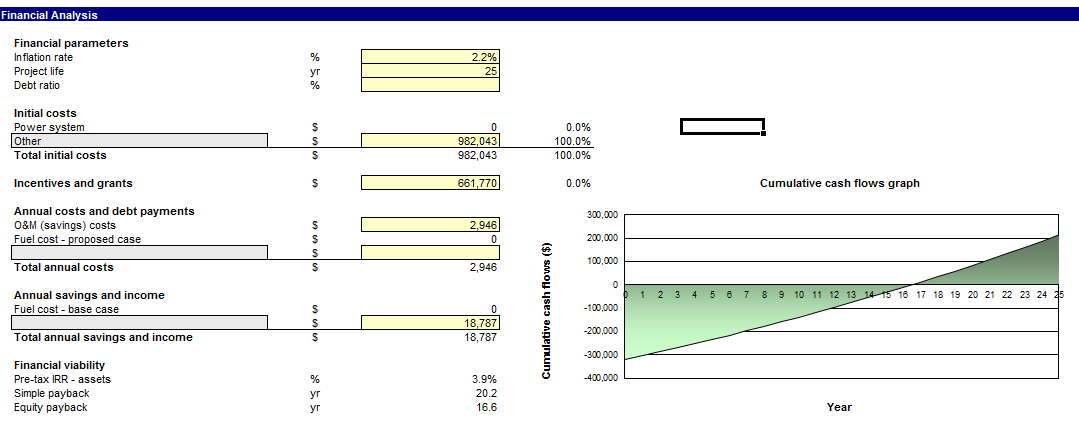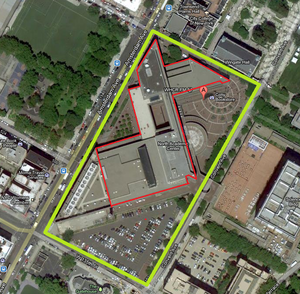
CCNY is a full participant in The City University of New York (CUNY) Sustainability Initiative, which is part of Mayor Bloomberg's PlaNYC for a sustainable city. CUNY has pledged to reduce carbon emissions 30% by 2017 to satisfy PlaNYC and CCNY is doing its part. CCNY has committed to implement measures that will reduce energy consumption in existing campus buildings and infrastructure. Solar energy is a renewable energy that has taken serious consideration among these measures to reduce energy consumption. A Rooftop Photovoltaic System on the North Academic Center (NAC) building was analyzed for its energy and carbon emission reduction. Calculations for the performance of the PV system were performed using the renewable energy screening tool RETScreen. A total of 165 kW can be produced using 15,579 ft2 of collector area, which equates to 1000 solar panels being used. The annual electricity production from the PV array totals 170,794 kWh/year, which is only 0.61% of the North Academic Center building's electricity consumption. The total net annual GHG emission reduction is 92.8 tCO2, which equates to 17 cars and light trucks not being used and 495 trees being planted. The installation cost was calculated to be $982, 043 with all the federal, state and city incentives amounting to $661,770. There are two plausible ways of which this project could be financed: (1) Federal or state grants which would mean that the project would be fully or partially funded with the college having only to deal with O&M costs, and (2) partnership with a private company so as to receive the available incentives making the project less of a financial burden. I believe that the partnership option is the most affordable deal. With this deal, incentives amount to $661,770, which reduces the initial amount by 67.4%. Annual savings of $18,787 generated from the PV system with a 2.2% inflation rate, results in a 20 year payback period.
Introduction[edit | edit source]
CCNY is a charter signatory to the American College and University Presidents Climate Commitment (ACUPCC), and is addressing climate change by reducing campus energy use and greenhouse gas emissions. CCNY is also a full participant in The City University of New York (CUNY) Sustainability Initiative, which is part of Mayor Bloomberg's PlaNYC for a sustainable city. CUNY has pledged to reduce carbon emissions 30% by 2017 to satisfy PlaNYC and CCNY is doing its part. CCNY has committed to implement measures that will reduce energy consumption in existing campus buildings and infrastructure, where approximately 80% of campus energy is consumed, in addition to actions that reduce greenhouse gas emissions through changes in behavior.
Among these measures to reduce energy consumption, solar energy is a renewable energy that has gotten serious consideration. Photovoltaic (PV) technology uses semiconductor materials such as silicon to convert sunlight directly into electricity. Solar cells are the basic building blocks of the complete system. To provide useful amounts of power, solar cells are wired together to create solar panels. The PV systems also require an inverter that converts the direct current (DC) electricity produced by the system into alternating current (AC) electricity. The amount of power that a PV panel will deliver is proportional to the amount of sunlight that falls on it. Since PV is a summer peaking generation source it will allow CCNY to moderate a portion of its summertime peak demand. Reducing peak demand not only has beneficial cost implications, but helps to stabilize the local utility grid by reducing delivery stress on the system during the peak hours of electricity consumption, which is a critical concern in New York City.
The North Academic Center (NAC) has the highest electricity demand out of all of the buildings of CCNY, weighing in at 51% of the total electric demand (over 28×106 kWh/year) [1]. This is one of the reasons that the NAC building was chosen for this project. Another great reason why this building was chosen is that there is adequate space on the rooftop for a PV system. There is an estimated 19,897 ft2 of useable area on the rooftop of the NAC building [1]. Even though other buildings on the campus have available useable area, this project will only focus on the NAC building. The exact available area locations on the rooftop of the NAC building will be shown, along with the proposed setup of the PV system. Calculations for the performance of the PV system were performed using the renewable energy screening tool RETScreen. A similar tool also used, mostly for a cost analysis and comparison purposes, was a tool created by the City University of New York called NY Solar Map [4]. NY Solar map is an online, interactive tool that helps New Yorkers understand the solar potential of their homes and businesses.
The North Academic Center[edit | edit source]
The study area is around 101,532 ft2 with approximately 19,897 ft2 of useable area [1], making this building the building with the largest amount of useable space out of all the CCNY buildings. This area was used as the upper limit of installed array size when sizing the systems with RETSCREEN. The actual square footage used by the PV panels was determined by the size of the type of panel used. Interestingly when using the NYC Solar Map, the program says that the usable area for the NAC building is 68, 189 ft2. This number is larger than the useable area calculated in [1], this is due to the fact that the program does not account for the mechanical equipment on the roof so the number is not an actual number. To acquire the exact number a survey of the roof must be done as done in the works of the O'Brien & Gere Engineers [1].

Rooftop PV System Design[edit | edit source]
The design of this rooftop PV system was done with the help of the energy analysis software RETScreen. RETScreen is developed and maintained by the Government of Canada through Natural Resources Canada's CanmetENERGY research center in Varennes, Quebec and is supported by an international network of experts from industry, government and academia. The RETScreen Software Suite is a unique decision support tool developed with the contribution of numerous experts from government, industry, and academia. The software, provided free-of-charge, can be used worldwide to evaluate the energy production and savings, costs, emission reductions, financial viability and risk for various types of Renewable-energy and Energy-efficient Technologies (RETs). RETScreen 4, which was used in this study, is an Excel-based clean energy project analysis software tool that helps decision makers quickly and inexpensively determine the technical and financial viability of potential renewable energy, energy efficiency and cogeneration projects.
The rooftop solar PV system was based on the GE mono-SI-GEPV-165-m solar panel. It features 54 single-crystal cells connected in series which were designed for optimal use in commercial grid-tied applications [3]. It has a 25-year limited warranty on power output and a 5-year limited warranty on materials and workmanship. One of the key benefits of this solar panel that influenced its selection is that it is engineered for the most rugged of locations including those which experience hail, snow, and ice storms.
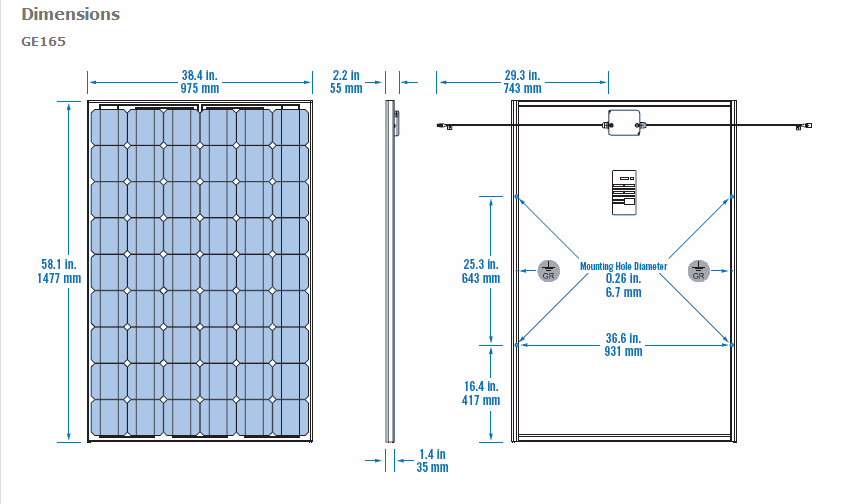
The solar panel has an 11.4% conversion efficiency based on the DC power output. The array is assumed to be on a fixed mode at 30 degrees, facing south, with no obstructions. The azimuth angle used was 232 degrees which was calculated using the Solar Position Calculator from the NOAA-ESRL website. A total of 170 kW can be produced using 15,579 ft2 of collector area; which equates to 1000 solar panels being used. The annual electricity production from the PV array totals 170,794 kWh/year, which is only 0.61% of the North Academic Center building's electricity consumption. It was assumed that the inverter used had a transfer efficiency of 95% with a capacity of 175 kW and no miscellaneous losses.
Google SketchUp 8 was used to determine the exact available area locations on the rooftop of the NAC building, along with the proposed setup of the PV system. Through Google SketchUp's integrated Google maps the satellite image of the NAC building was imported into the program. The study area was traced including all the miscellaneous mechanical equipment on the rooftop. The exact sizes of the solar panels were drawn and they were placed in the most ideal locations, with limited to no obstructions. Figure below shows the proposed rooftop PV system to be implemented to the NAC Building.
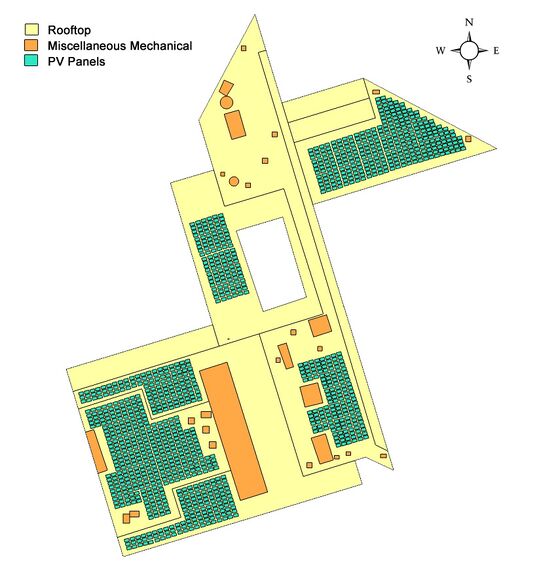
Emission Analysis[edit | edit source]
Greenhouse gas (GHG) reductions were also calculated in RETScreen 4. The GHG emission factor used is 0.544 tCO2/MWh, for fuels of all types in the United States, where tCO2 stands for ton of carbon dioxide equivalent emissions. Therefore as seen in the figure below, with a calculated amount of electricity created equaling to 170.794 MWh, the total net annual GHG emission reduction is 92.8 tCO2, which equates to 17 cars and light trucks not being used and 495 trees planted [4].

Financial Analysis[edit | edit source]
Installation Cost/Energy Generation[edit | edit source]
The installed cost of solar PV varies significantly depending upon site conditions, as well as changes in the market. Table 1 shows the average installation cost of a project depending on the projects system size [4]. Based on the 165kW project proposed here an average installed cost of $5.75/W for rooftop PV systems, the cost of the PV system is 165kW×1000W/kW×$5.75/W = $982, 043.
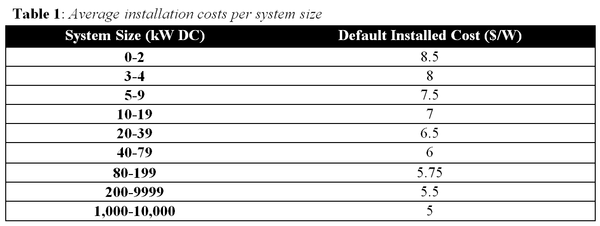
CCNY pays a yearly average of $0.11/kWh [1], which means that for the NAC building alone, they pay around $3.1million a year for electricity. Therefore for a 170,794 kWh/year energy generation from the PV system results in $18,787.
Operations and Management[edit | edit source]
The assumption of annual O&M costs are 0.3 % of total installed cost based on information from the US Department of Energy's paper [6]. Therefore the annual O&M costs are calculated to be $2946.
Financing Options[edit | edit source]
There are two plausible options than can be taken to finance this project. Since the City College of NY is a non-profit state organization, they are not eligible for the various incentives. Therefore the first financing option is to acquire a federal, state or city grant to finance the majority or the entire project. The other option would be to partner with a private company, this way the company would be eligible for the various incentives. This option has been done before and seems to work well. An example of this is seen on the PV rooftop system projects at Smith College in Northampton, MA and Eastern University in St. Davids, PA. The colleges partnered with Community Energy to install solar panels on the roof of Centers at both colleges [7]. The solar system will be financed through a Power Purchase Agreement (PPA) with renewable energy developer and marketer Community Energy, Inc. Under the agreement, Community Energy will own and operate the systems, which enable the colleges to take advantage of the renewable power source without funding the system's purchase up front. Community Energy will sell the colleges electricity produced by the system at a locked-in rate for 20 years, insulating the college from rising energy costs. In the next section if this financial analysis we will explore the incentives available for NYC.
Incentive (where applicable)[edit | edit source]
They are 5 types of incentives that are available, 4 of which this project can receive; seen in table 2. PlaNYC has a Solar PV Incentive Guide that explains all of the incentives available in detail

For the State incentive, NYSERDA/LIPA, you are eligible to receive $1500 per kW for up to only 50kW, which makes it $75,000. With the federal tax credit, you are allowed to receive 30% of the cost of the solar installed. This turns out to be a savings of $294, 612. This project would not be eligible for the Residential State tax credit because it is not a residential building and it is not eligible for NYC Property Tax Abatement because that ends in December 2012. Last but not least the Modified Accelerated Cost-Recovery System, (MACRS) + 50% Bonus Depreciation in Year 1 incentive amounts to $292,158. Together all of the incentives add up to $661,770, which is about 67.4% of the total cost.
Final Costs[edit | edit source]
Keeping in mind that they are two reasonable options that can be made in order to finance this project we will talk about both cases in terms of the final cost. In the first case where the school receives a grant to fund the installation of the project, it is simple math. The only additional cost that will have to be paid each year would be the operations and management costs. Figure 8 shows the RETScreen financial analysis section if the project was to be 100% funded by a grant. If the college goes into a partnership with a private company the financial analysis can be seen in figure 9. With an installation cost of $982, 043 and a total incentive amount of $661,770, the initial cost is now reduced to $320, 273. With an inflation rate of 2.2% and an annual savings of $18,787 generated from the PV system, this results in slightly more than a 20 year payback period and an equity payback of about 17 years. Of course the college and the private company will have to decide a positive solution for both parties in order for the project to be feasible.
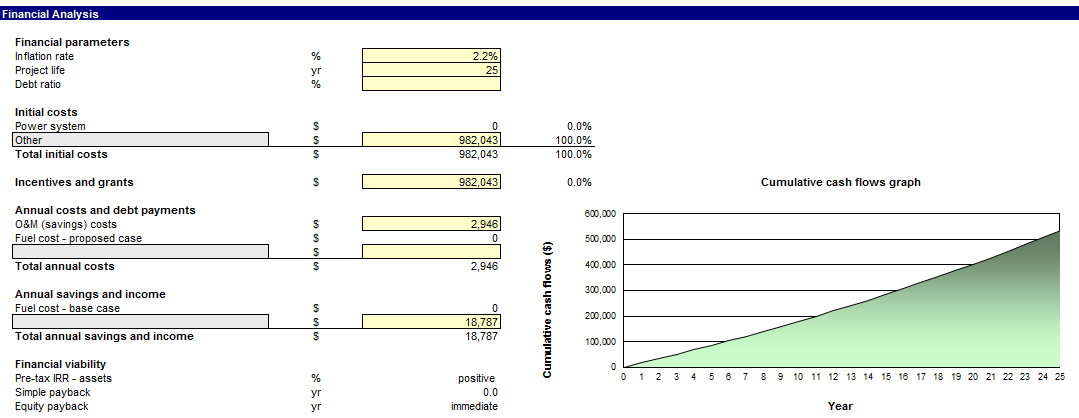
RETScreen Financial Analysis if funded by a grant
RETScreen Financial Analysis if partnership with private company
Conclusion[edit | edit source]
The proposed rooftop PV system for the NAC building would have an annual electricity production totaling 170,794 kWh/year. This translates to a total net annual GHG emission reduction is 92.8 tCO2. The installation cost of this project was calculated to be around $982, 043.There are two plausible ways of which this project could be financed: (1) Federal or state grants which would mean that the project would be fully or partially funded with the college having only to deal with O&M costs, and (2) partnership with a private company so as to receive the available incentives making the project less of a financial burden. I believe that the partnership option is the most affordable deal. With this deal, incentives amount to $661,770, which reduces the initial amount by 67.4%. Annual savings of $18,787 generated from the PV system, results in a 20 year payback period. The system would be beneficial in helping not only CCNY and CUNY as a whole help to reduce their energy consumption and greenhouse gas emissions, but more must be done to achieve the goals set. Solar technology alone will not help to reduce CCNY's energy consumption. With increasing incentives being given for renewable energy practices, there is a bright future for this industry. Let's hope that the promise of only financial gain will determine the outcome of future works.
References[edit | edit source]
- Letkiewicz, D., 2010. "CCNY Campus Energy Assessment". January. O'Brien & Gere Engineers, Inc.
- Natural Resources Canada, 2010. "RETScreen Software Suite". <www.retscreen.net /ang/software_and_data.php>. RETScreen International
- Sustainable CUNY,2012. "NYC Solar PV Incentive Guide: Commercial". < http://www.cuny.edu/about/resources/sustainability/solar-america/installingsolar/incentives.html>. The City University of New York.
- CUNY, 2007. 'NYC Solar Map". <ww.nycsolarmap.com>. PlaNYC and The New York City Economic Development Corporation.
- Cornwall, C., Houriuchi, A., Lehman, C., 2012. "Solar position Calculator". < http://www.esrl.noaa.gov/gmd/grad/solcalc/ azel.html >. NOAA- ESRL.
- US Department of Energy, 2006. "Solar Energy Technologies Program: Multi-Year Program Plan 2007-2011".
- Community Energy Inc., 2012. "Smith College & Eastern University". <http://web.archive.org/web/20121218043620/http://www.communityenergyinc.com:80/wind-farms/highered100/easternu00/>.
